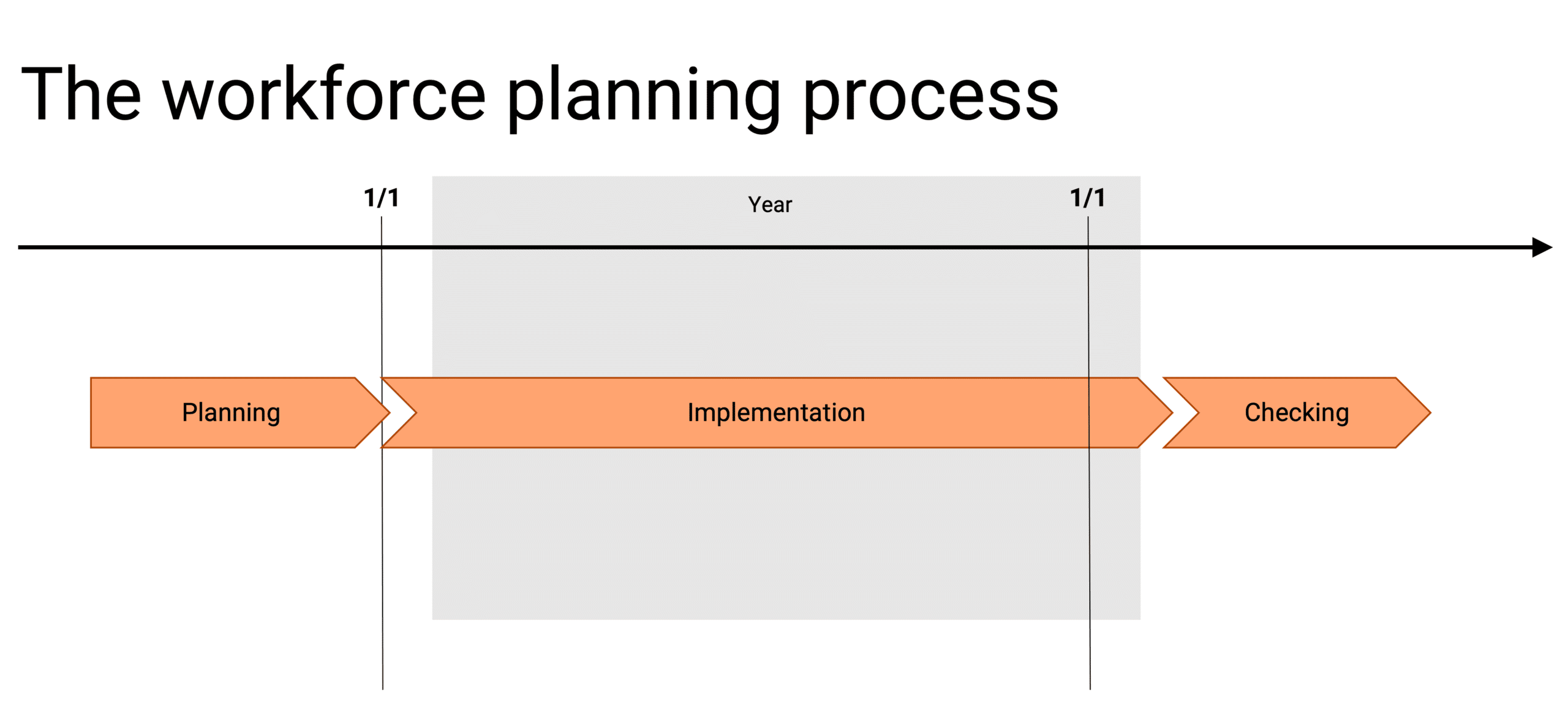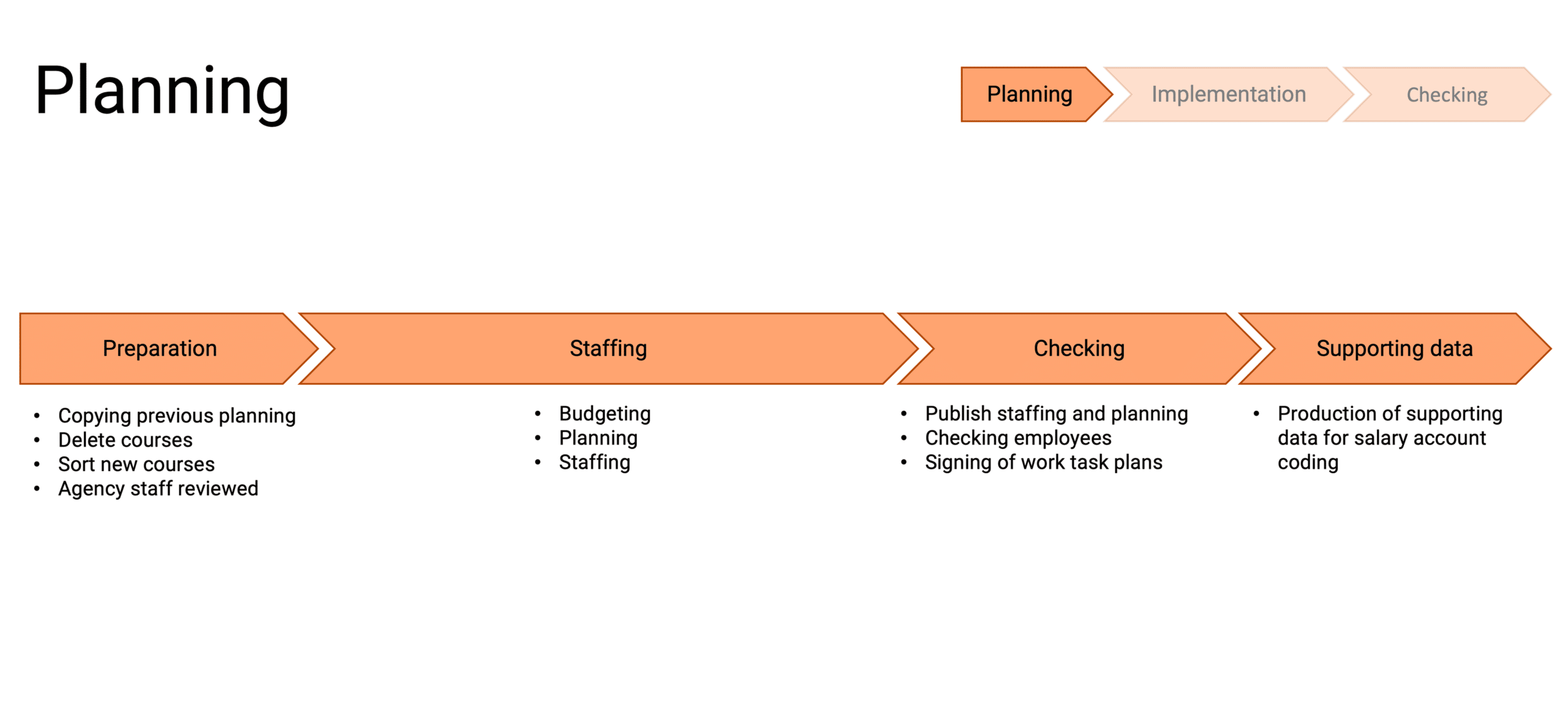Keep an eye on the various parts of the workforce planning process
Having a joint workforce planning process at a higher education institution provides the institution with a clear strategic advantage. The process will become an important basis for the institution’s development and its work on continuous improvement. It provides the employees with a better understanding of how things work and where they fit in. Everyone experiences greater affinity with the work, feels more appreciated and gains a greater understanding of the importance of work carried out by them and others for the end result.
A joint workforce planning process also makes it easier to communicate within the organisation when everyone has the same understanding of the process. The management’s decision-making process also becomes easier when the organisation obtains uniform, complete and equivalent supporting data for decisions.
Overview
Regardless of which higher education institution it is, the workforce planning process largely passes through the same overall stages. The characteristic feature of the process is that it is repeated in advance of each operating year and contains the stages of planning, implementation and checking. The process can also be divided into half-years, with planning, implementation and checking per half-year.

The workforce planning process
The planning stage
During the planning stage, you produce complete plans for the next period. The planning stage is in turn divided into the stages of Preparations, Staff Allocation, Checking and Supporting Data for Account-Coding.

In Preparations, it is common to copy the previous year’s planning because staff allocation and course planning are largely the same as in previous years. After copying, you remove courses that are no longer in existence and new courses added are sorted in their correct place in the structure.
New courses are automatically entered through integration with the higher education institution’s course system. External staff who are no longer available for allocation are terminated and new external personnel are registered manually.
Staff Allocation is the stage where the actual course planning and staffing take place. The first step is to review the number of planned students and the expected throughput. Next, the workforce planning system calculates the estimated budget for the course based on the formula that the department uses for that purpose. The estimated budget is used as a basis for assigning the actual budget for the course. The actual budget can be either larger or smaller depending on the current conditions for the course. You will later compare staff allocation against the actual budget to ensure that staff allocation has not exceeded the budget.
The staff allocation and course planning will take place after that. By “course planning” we mean the detailed planning of lectures, laboratory sessions, responsibility for the course and examinations, etc. The course coordinator usually carried this out. Course planning then forms the basis for allocation of staff. However, the course coordinator often has no mandate to decide on staff allocation him or herself, since this requires an overall view of staff allocation. Instead, the course coordinator may submit the requested staff allocation to the person responsible for staff allocation.
When all course planning has been carried out and all requests for staff allocation have been received, the staff allocation itself takes place. This determines which requests will be approved and which requests need to be adjusted. In this situation, any loans of staff from and to other departments at the higher education institution also take place.
Course planning is not always delegated to the course coordinator in the manner described above. Instead, both course planning and staff allocation can sometimes be carried out by the same person. The way in which a higher education institution carries out course planning and staff allocation can also vary from one department to another within the institution.
If the financial perspective is important, you now also carry out an analysis of income and costs for each individual course to see whether the planning is within the financial framework.
When the planning is complete, it is usually published for the staff. Discussions with employees are then held. The personal work task plans are now signed if the working hours agreement so requires.
Once you have checked the planning, it is time for the finance administrators to pick out supporting data for account-coding for staff salaries. The supporting data is then recorded in the human resources system and forms the basis for the financial report.
The implementation stage
During the implementation stage, you revise plans on a continuous basis as changes take place in the organisation. Examples of changes include staff who leave the organisation or who are absent for various reasons (sickness, parental leave, leave of absence, etc.) or if the conditions for a course change, for example if not as many students register as were planned for. To facilitate revision of plans, it is important for there to be integration with the human resources system so the planner becomes aware of all cases of absence relating to the staff.
During the implementation stage, you also check the planning against the account-coding for salaries entered in the human resources system: the coding is updated with the outcome up to the date of the check and the next salary account-coding is updated so it conforms to the new planning. The frequency of the check varies from never to half-yearly or quarterly.
The Checking stage
At the end of the operating year, you carry out a check on additional time and overtime for the staff and any excess is transferred to the next operating year or is paid as compensation. A final check on the account-coding for the staff is then carried out.
Dependencies on other processes
The workforce planning process is also linked to long-term course planning, budget work, financial reporting and scheduling.
Roles and responsibilities that are important for a complete process
A complete staffing procedure also requires a description of all the roles involved and their respective responsibilities. Examples of roles include the person who has overall responsibility for the entire process, for staff allocation, for course planning and for finances. It is also important to set a deadline for completion of each activity.
Finally
Implementing a joint workforce planning process throughout the higher education institution provides many benefits, but can also be a challenge. The procurement of a joint workforce planning system for the institution provides effective support for the introduction. A workforce planning system provides the functions, views and reports required for efficient work on the selected process. A workforce planning system also provides more benefits for the higher education institution. Click on the link for a description of the main benefits of a workforce planning system. designed for higher education institutions. If you currently use proprietary workforce planning solutions such as Excel in some parts of your organisation, you may want to learn about the limitations of workforce planning solutions in Excel.
About the author
Jens Apelgren has over ten years’ experience in workforce planning at higher education institutions and has personally introduced workforce planning systems at 18 different institutions. Jens is CEO of Retendo AB, which offers systems to streamline administration for both higher education institutions and project-oriented companies. Jens is closely involved in the development of Retendo’s workforce planning system.




